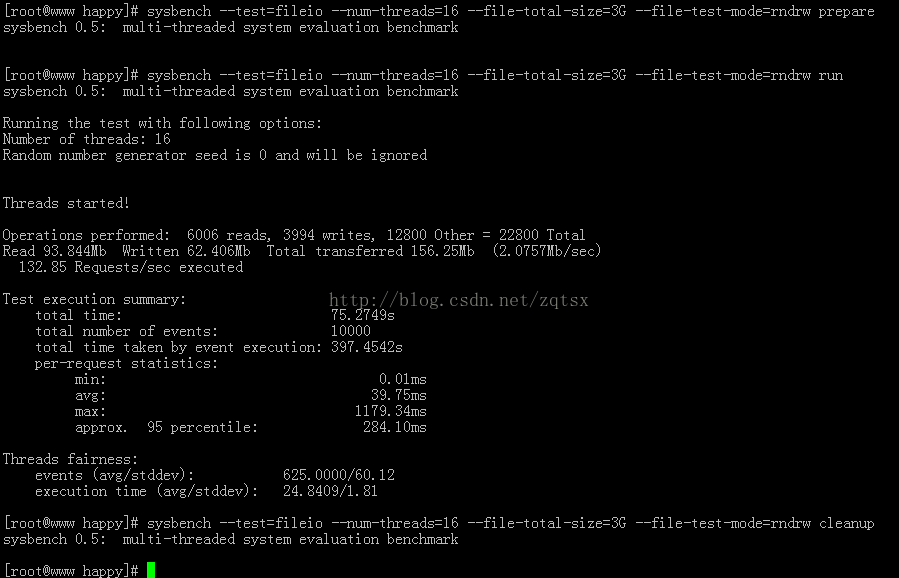使用sysbench进行cpu/IO/内存/OLTP等基准测试
一、sysbench-0.5安装
软件下载地址:http://download.csdn.net/detail/zqtsx/8368857 或Email至“摘取天上星”获取(本文PDF文档下载地址 http://download.csdn.net/detail/zqtsx/8368939 )
tar zxvf sysbench-0.5tar.gz
cd sysbench-0.5 (与其他软件包不同的是解压缩后,默认没有configure文件,所以需要先执行 autogen.sh 文件 才可以使用./configure进行编译安装)
./autogen.sh 如下图:
执行编译命令:
./configure --with-mysql-includes=/usr/local/mysql/include --with-mysql-libs=/usr/local/mysql/lib 如下图

(注:这里必须制定MYSQL数据库文件目录,否则会提示如下图错误)
然后执行 make && make install
安装成功后如下图所示 即为安装成功
二、用法(下面的测试案例需要用到这些说明才能看的懂的)
1:用法 (摘取天上星 整理)
sysbench [general-options]… –test=[test-options]… command 通用选项: --num-threads=N 创建测试线程的数目。默认为1. --max-requests=N 请求的最大数目。默认为10000,0代表不限制。 --max-time=N 最大执行时间,单位是s。默认是0,不限制。 --forced-shutdown=STRING 超过max-time强制中断。默认是off。 --thread-stack-size=SIZE 每个线程的堆栈大小。默认是32K。 --init-rng=[on|off] 在测试开始时是否初始化随机数发生器。默认是off。 --test=STRING 指定测试项目名称。 --debug=[on|off] 是否显示更多的调试信息。默认是off。 --validate=[on|off] 在可能情况下执行验证检查。默认是off。
|
1
2
3
4
5
6
7
8
9
|
测试项目:
fileio – File I/O test
cpu – CPU performance test
memory – Memory functions speed test
threads – Threads subsystem performance test
mutex – Mutex performance test(互斥性能测试)
oltp – OLTP test (联机事务处理系统)
指令: prepare(测试前准备工作) run(正式测试) cleanup(测试后删掉测试数据) help version
See ‘sysbench –test=
for
a list of options
for
each test. 查看每个测试项目的更多选项列表。
|
|
1
2
3
4
5
6
7
8
9
10
11
12
13
|
# ./sysbench –test=fileio help
--file-num=N 创建测试文件的数量。默认是128
--file-block-size=N 测试时文件块的大小。默认是16384(16K)
--file-total-size=SIZE 测试文件的总大小。默认是2G
--file-test-mode=STRING 文件测试模式{seqwr(顺序写), seqrewr(顺序读写), seqrd(顺序读), rndrd(随机读), rndwr(随机写), rndrw(随机读写)}
--file-io-mode=STRING 文件操作模式{sync(同步),async(异步),fastmmap(快速map映射),slowmmap(慢map映射)}。默认是sync
--file-extra-flags=STRING 使用额外的标志来打开文件{sync,dsync,direct} 。默认为空
--file-fsync-freq=N 执行fsync()的频率。(0–不使用fsync())。默认是100
--file-fsync-all=[
on
|off] 每执行完一次写操作就执行一次fsync。默认是off
--file-fsync-end=[
on
|off] 在测试结束时才执行fsync。默认是
on
--file-fsync-mode=STRING 使用哪种方法进行同步{fsync, fdatasync}。默认是fsync
--file-merged-requests=N 如果可以,合并最多的IO请求数(0–表示不合并)。默认是0
--file-rw-ratio=N 测试时的读写比例。默认是1.5
|
|
1
2
|
# sysbench --test=cpu help
--cpu-max-prime=N 最大质数发生器数量。默认是10000
|
|
1
2
3
4
5
6
7
|
# sysbench --test=memory help
--memory-block-size=SIZE 测试时内存块大小。默认是1K
--memory-total-size=SIZE 传输数据的总大小。默认是100G
--memory-scope=STRING 内存访问范围{global,local}。默认是global
--memory-hugetlb=[
on
|off] 从HugeTLB池内存分配。默认是off
--memory-oper=STRING 内存操作类型。{read, write, none} 默认是write
--memory-access-mode=STRING存储器存取方式{seq,rnd} 默认是seq
|
|
1
2
3
|
# sysbench --test=threads help
--thread-yields=N 每个请求产生多少个线程。默认是1000
--thread-locks=N 每个线程的锁的数量。默认是8
|
|
1
2
3
4
|
# sysbench --test=mutex help
--mutex-num=N 数组互斥的总大小。默认是4096
--mutex-locks=N 每个线程互斥锁的数量。默认是50000
--mutex-loops=N 内部互斥锁的空循环数量。默认是10000
|
# sysbench --test=oltp help oltp options: --oltp-test-mode=STRING 执行模式{simple,complex(advanced transactional),nontrx(non-transactional),sp}。默认是complex --oltp-reconnect-mode=STRING 重新连接模式{session(不使用重新连接。每个线程断开只在测试结束),transaction(在每次事务结束后重新连接),query(在每个 SQL语句执行完重新连接),random(对于每个事务随机选择以上重新连接模式)}。默认是session --oltp-sp-name=STRING 存储过程的名称。默认为空 --oltp-read-only=[on|off] 只读模式。Update,delete,insert语句不可执行。默认是off --oltp-skip-trx=[on|off] 省略begin/commit语句。默认是off --oltp-range-size=N 查询范围。默认是100 --oltp-point-selects=N number of point selects [10] --oltp-simple-ranges=N number of simple ranges [1] --oltp-sum-ranges=N number of sum ranges [1] --oltp-order-ranges=N number of ordered ranges [1] --oltp-distinct-ranges=N number of distinct ranges [1] --oltp-index-updates=N number of index update [1] --oltp-non-index-updates=N number of non-index updates [1] --oltp-nontrx-mode=STRING 查询类型对于非事务执行模式{select, update_key, update_nokey, insert, delete} [select] --oltp-auto-inc=[on|off] AUTO_INCREMENT是否开启。默认是on --oltp-connect-delay=N 在多少微秒后连接数据库。默认是10000 --oltp-user-delay-min=N 每个请求最短等待时间。单位是ms。默认是0 --oltp-user-delay-max=N 每个请求最长等待时间。单位是ms。默认是0 --oltp-table-name=STRING 测试时使用到的表名。默认是sbtest --oltp-table-size=N 测试表的记录数。默认是10000 --oltp-dist-type=STRING 分布的随机数{uniform(均匀分布),Gaussian(高斯分布),special(空间分布)}。默认是special --oltp-dist-iter=N 产生数的迭代次数。默认是12 --oltp-dist-pct=N 值的百分比被视为’special’ (for special distribution)。默认是1 --oltp-dist-res=N ‘special’的百分比值。默认是75 General database options: --db-driver=STRING 指定数据库驱动程序(‘help’ to get list of available drivers) --db-ps-mode=STRING编制报表使用模式{auto, disable} [auto] Compiled-in database drivers: --mysql – MySQL driver mysql options: --mysql-host=[LIST,...] MySQL server host [localhost] --mysql-port=N MySQL server port [3306] --mysql-socket=STRING MySQL socket --mysql-user=STRING MySQL user [sbtest] --mysql-password=STRING MySQL password [] --mysql-db=STRING MySQL database name [sbtest] --mysql-table-engine=STRING storage engine to use for the test table {myisam,innodb,bdb,heap,ndbcluster,federated} [innodb] --mysql-engine-trx=STRING whether storage engine used is transactional or not {yes,no,auto} [auto] --mysql-ssl=[on|off] use SSL connections, if available in the client library [off] --myisam-max-rows=N max-rows parameter for MyISAM tables [1000000] --mysql-create-options=STRING additional options passed to CREATE TABLE []
2:解释
cpu性能测试【找范围内最大素数{时间越短越好}】
线程调度【线程并发执行,循环响应信号量花费的时间{越少越好}】
互斥锁【并发线程同时申请互斥锁循环一定次数花费的时间{越少越好}】
内存【以不同块大小传输一定数量的数据吞吐量大小{越大越好}】
IO【不同场景下IOPS{越大越好}】
注意prepare run cleanup 清楚测试时创建的 测试文件
三、开始测试
编译成功之后,就要开始测试各种性能了,测试的方法官网网站上也提到一些,但涉及到 OLTP 测试的部分却不够准确。在这里我大致提一下:1、cpu性能测试
自己可以根据机器cpu的性能来适当调整数值。如下二图查看CPU配置!
执行命令 sysbench --test=cpu --cpu-max-prime=20000 run 进行CPU测试
cpu测试主要是进行素数的加法运算,在下图例子中,指定了最大的质数发生器数量为 20000,可以看出“摘取天上星”的小云服务器此次测试 执行时间 大约为26.62秒
2、线程测试
sysbench --test=threads --num-threads=64 --thread-yields=100 --thread-locks=2 run如下图 (发送64次/个测试线程请求,每次/个线程请求产生/生成100个数量,每个线程的锁数量为2) ,下图的测试执行时间为1.3925秒
3、磁盘IO性能测试
首先创建要测试用的文件sysbench --test=fileio --num-threads=16 --file-total-size=3G --file-test-mode=rndrw prepare
其次进行磁盘IO测试
sysbench --test=fileio --num-threads=16 --file-total-size=3G --file-test-mode=rndrw run
最后测试完成后,用以下命令清除测试时 创建的测试文件
sysbench --test=fileio --num-threads=16 --file-total-size=3G --file-test-mode=rndrw cleanup
上述参数指定了最大创建16个线程,创建的文件总大小为3G,文件读写模式为随机读。
下图为整个测试过程,包括创建测试文件、执行测试、删除测试文件等 所有流程
可以看到“2.0757Mb/sec”(即每秒2.0757Mb 的读取速度,说明小云服务器的磁盘IO速度不佳), 132.85 Requests/sec( 即每秒请求数量为132.85个)
这些数据对磁盘的评测非常有用...
4、内存测试
sysbench --test=memory --memory-block-size=8k --memory-total-size=4G run上述参数指定了本次测试整个过程是在内存中传输 4G 的数据量,每个 block 大小为 8K。测试结果如下图:
执行时间为0.6503秒,每秒传输速度为6298.21Mb每秒
5、OLTP测试
sysbench --test=oltp --mysql-table-engine=myisam --oltp-table-size=1000000 --mysql-socket=/tmp/mysql.sock --mysql-user=test --mysql-host=localhost --mysql-password=test prepare上述参数指定了本次测试的表存储引擎类型为 myisam,这里需要注意的是,官方网站上的参数有一处有误,即 --mysql-table-engine,官方网站上写的是 --mysql-table-type,这个应该是没有及时更新导致的。另外,指定了表最大记录数为 1000000,其他参数就很好理解了,主要是指定登录方式。测试 OLTP 时,可以自己先创建数据库 sbtest,或者自己用参数 --mysql-db 来指定其他数据库。--mysql-table-engine 还可以指定为 innodb 等 MySQL 支持的表存储引擎类型。
测试进行到这里暂时告一段落,犹豫时间关系,和当前博客服务器网络延迟问题, 关于MYSQL数据库的测试截图暂未上传(等周一网络好的时候再补上),更多内容请关注 摘取天上星 的技术博客http://blog.csdn.net/zqtsx



